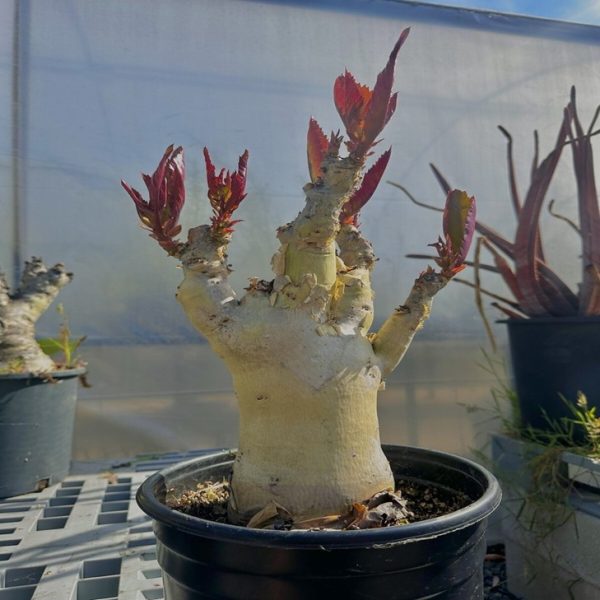Cyphostemma juttae
aka “Namibian Grape,” “Tree Grape,” or just “that insane succulent with grapevine leaves”
Quick Facts
- Scientific Name: Cyphostemma juttae
- Family: Vitaceae (yep — the grapevine family )
- Origin: Namibia and parts of southern Africa
- Growth Habit: Deciduous succulent shrub/small tree
- Famous For: Huge, swollen trunk + lush tropical leaves = wild visual contrast (Cyphostemma Juttae)
Appearance
- Caudex / Trunk:
- Thick, swollen, water-storing trunk — can reach over 1 meter wide with age
- Smooth, peeling bark in tan to golden hues
- Stores water like a baobab, allowing it to survive long dry spells
- Leaves:
- Large, green, grapevine-like leaves with toothed edges
- Soft and juicy-looking in the growing season
- Deciduous — drops all leaves in winter or during drought, leaving behind a chunky, dramatic silhouette
- Height: 1.5–3 meters tall in cultivation (can get bigger in habitat) (Cyphostemma Juttae)
Flowers & Fruit
- Flowers: Small, yellow-green clusters — not super flashy
- Fruit: Bright red to purple grape-like berries (NOT edible — toxic)
- The fruit adds ornamental value and attracts attention when present
Natural Habitat
- Grows in rocky, arid desert regions of Namibia
- Adapted to survive heat, drought, and extreme light exposure
- Thrives in well-drained, rocky soils with minimal organic matter
Cultivation & Care
Despite its exotic look, Cyphostemma juttae is easy to grow with the right setup:
- Light: Full sun to very bright light — essential for compact growth and leaf color
- Soil: Super well-draining — cactus/succulent mix with added pumice or perlite
- Water:
- Regular watering in summer while in leaf
- Completely dry in winter — it’s dormant and vulnerable to rot
- Temperature: Not frost-hardy
- Keep above 5°C (41°F); protect from cold, wet winters
- Growth Rate: Slow, especially at first — but worth the patience! (Cyphostemma Juttae)
⚠️ Care Tips
- Overwatering = instant root rot — let it dry out fully between waterings
- Pots: Use clay pots for better breathability and drainage
- Pruning: Can be pruned to shape or reduce legginess in older plants
- Pests: Occasionally susceptible to mealybugs, but generally hardy
️ Conservation & Ethics
- Not endangered, but native habitat is vulnerable
- Always buy nursery-grown plants, never wild-collected
Why It’s a Star
- Looks tropical, but acts like a desert survivor
- Caudex + lush leaves = an incredible contrast
- Perfect for xeriscaping, sculptural pots, and collectors who love weird, bold plants
- Often called “one of the most beautiful succulents in the world”

Reviews
There are no reviews yet.